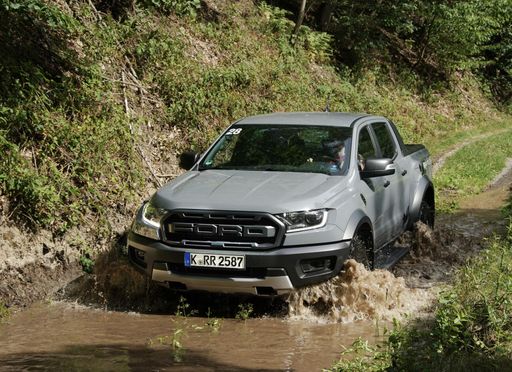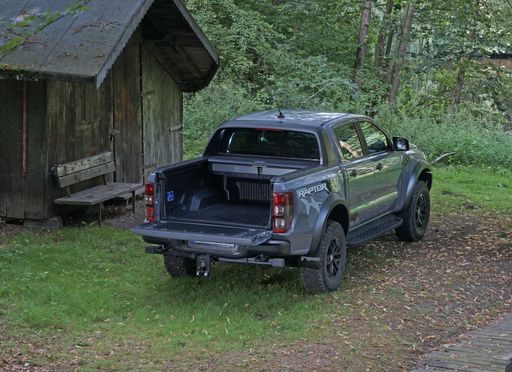Ford Ranger vs Vauxhall Rocks Electric – Differences & prices compared
Compare performance, boot space, consumption and price in one view.
Find out now: which car is the better choice for you – Ford Ranger or Vauxhall Rocks Electric?
The Ford Ranger (Pickup) comes with a Diesel, Petrol or Plugin Hybrid engine and Manuel or Automatic transmission. In comparison, the Vauxhall Rocks Electric (Hatchback) features a Electric engine with Automatic transmission.
When it comes to boot capacity, the Ford Ranger offers , while the Vauxhall Rocks Electric provides 63 L – depending on how much space you need. If you’re looking for more power, decide whether the 292 HP of the Ford Ranger or the 8 HP of the Vauxhall Rocks Electric suits your needs better.
In terms of consumption, the values are 3.10 L per 100 km for the Ford Ranger, and for the Vauxhall Rocks Electric.
Price-wise, the Ford Ranger starts at 34500 £, while the Vauxhall Rocks Electric is available from 6800 £. Compare all the details and find out which model fits your lifestyle best!
Ford Ranger
The Ford Ranger stands out in the pickup market with its robust build and versatile capabilities, making it a popular choice for both work and leisure. Its modern design is complemented by a well-equipped interior, providing comfort and advanced technology. Whether tackling challenging terrains or cruising through the city, the Ranger delivers a reliable and dynamic driving experience.
details @ media.ford.com
@ media.ford.com
 @ media.ford.com
@ media.ford.com
Vauxhall Rocks Electric
The Opel Rocks Electric stands out as a stylish and compact solution for urban mobility, offering both convenience and an eco-friendly commute. Its sleek design and vibrant colour options make it an attractive choice for those looking to navigate city streets with ease. This nimble vehicle not only promises a smooth ride but also enhances the overall urban driving experience.
details

|
|
|
|
|
Costs and Consumption |
|
|---|---|
|
Price
34500 - 68800 £
|
Price
6800 - 7500 £
|
|
Consumption L/100km
3.1 - 13.8 L
|
Consumption L/100km
-
|
|
Consumption kWh/100km
-
|
Consumption kWh/100km
-
|
|
Electric Range
50 km
|
Electric Range
75 km
|
|
Battery Capacity
11.80 kWh
|
Battery Capacity
5.40 kWh
|
|
co2
70 - 315 g/km
|
co2
0 g/km
|
|
Fuel tank capacity
80 L
|
Fuel tank capacity
-
|
Dimensions and Body |
|
|---|---|
|
Body Type
Pickup
|
Body Type
Hatchback
|
|
Seats
2 - 5
|
Seats
2
|
|
Doors
2 - 4
|
Doors
2
|
|
Curb weight
2082 - 2486 kg
|
Curb weight
558 kg
|
|
Trunk capacity
-
|
Trunk capacity
63 L
|
|
Length
5370 - 5420 mm
|
Length
2410 mm
|
|
Width
1918 - 1968 mm
|
Width
1388 mm
|
|
Height
1868 - 1922 mm
|
Height
1525 mm
|
|
Payload
676 - 1108 kg
|
Payload
142 kg
|
Engine and Performance |
|
|---|---|
|
Engine Type
Diesel, Petrol, Plugin Hybrid
|
Engine Type
Electric
|
|
Transmission
Manuel, Automatic
|
Transmission
Automatic
|
|
Transmission Detail
Schaltgetriebe, Automatikgetriebe
|
Transmission Detail
Reduction Gearbox
|
|
Drive Type
All-Wheel Drive
|
Drive Type
Front-Wheel Drive
|
|
Power HP
170 - 292 HP
|
Power HP
8 HP
|
|
Acceleration 0-100km/h
7.9 - 12.1 s
|
Acceleration 0-100km/h
-
|
|
Max Speed
180 - 190 km/h
|
Max Speed
45 km/h
|
|
Torque
405 - 697 Nm
|
Torque
40 Nm
|
|
Number of Cylinders
4 - 6
|
Number of Cylinders
-
|
|
Power kW
125 - 215 kW
|
Power kW
6 kW
|
|
Engine capacity
1996 - 2993 cm3
|
Engine capacity
-
|
General |
|
|---|---|
|
Model Year
2022 - 2025
|
Model Year
2025
|
|
CO2 Efficiency Class
G, B
|
CO2 Efficiency Class
A
|
|
Brand
Ford
|
Brand
Vauxhall
|
Ford Ranger
A Comprehensive Look at the Ford Ranger: Versatility Meets Innovation
The Ford Ranger has long been a staple in the world of pick-up trucks, renowned for its robust design and versatility. Whether for rugged off-road adventures or everyday utility tasks, the Ford Ranger continues to be a frontrunner in the pick-up segment. In this article, we explore the technical details and innovative features that set the latest versions of the Ford Ranger apart from its competitors.
Powertrain Performance: A Range of Choices
The Ford Ranger offers a selection of powerful engines, catering to a diverse set of user requirements. Engine options range from the fuel-efficient 2.0-litre EcoBlue diesel engine to the robust 3.0-litre EcoBoost petrol engine, offering impressive outputs from 170 to 292 PS. These engines are paired with either a manual or an advanced automatic transmission, both providing smooth shifting and optimised performance across various driving conditions.
The Ranger’s all-wheel-drive system ensures a robust off-road capability while maintaining a composed ride on urban roads. With torque figures ranging between 405 Nm and 600 Nm, the Ranger guarantees ample pulling power whether you're on or off the beaten track.
Fuel Efficiency and Environmental Considerations
Recognising the importance of balancing performance with efficiency, the Ford Ranger delivers competitive fuel consumption figures ranging from 8.4 to 13.8 litres per 100 km. Despite its robust performance capabilities, the Ranger remains mindful of its environmental footprint, maintaining a functional balance between power and efficiency with a CO2 efficiency class of G.
Advanced Safety and Technology Features
Incorporating cutting-edge technology, the Ford Ranger is equipped with a suite of safety features designed to protect both passengers and payload. Among these are adaptive cruise control, lane-keeping assistance, and a pre-collision assist system, enhancing the driver's ability to navigate both rural roads and busy motorways safely and efficiently.
Moreover, the interior tech suite includes an intuitive infotainment system, complete with connectivity options for seamless integration of smartphones and smart devices. This ensures drivers and passengers can stay connected and entertained on all journeys.
Customisation and Comfort
The Ford Ranger offers a variety of trim levels, allowing customers to tailor the vehicle to their specific needs. From the rugged XL 4x4 to the luxurious Platinum e-4WD Automatik, there is a model to suit every preference and requirement. Equipment lines such as Wildtrak and MS-RT add enhanced styling and additional features for those seeking a more distinctive and upscale appearance.
Inside, the Ranger provides comfortable seating configurations for up to five passengers, with premium materials and ample storage space to ensure every journey is a pleasant experience. Users can also benefit from a range of comfort features, including climate control, premium audio systems, and adjustable seating.
Practicality Meets Payload
The Ford Ranger excels in practicality with its impressive payload capacity and spacious cargo bed, suitable for carrying everything from work equipment to recreational gear. With a maximum payload of up to 1,108 kg, the Ranger is more than capable of handling heavy loads, making it an ideal choice for both professional and personal use.
Additionally, the robust chassis and durable build quality provide long-lasting performance even under the most demanding conditions, ensuring reliability and endurance in the long term.
Conclusion: A Resilient Companion for All Terrains
With its capable engine choices, outstanding off-road capabilities, and a host of advanced features, the Ford Ranger continues to lead the way in the pick-up truck category. Whether for practical utility, adventurous pursuits, or simply as a reliable daily vehicle, the Ranger delivers on all fronts – a true testament to Ford’s commitment to innovation and quality in the automotive industry.
Vauxhall Rocks Electric
Introducing the Opel Rocks Electric
The world of electric mobility continues to expand with innovative vehicles, and the Opel Rocks Electric is at the forefront of this evolution. Embracing a sustainable future, this compact urban mobility solution combines distinctive styling with practical features, appealing particularly to city dwellers seeking an efficient and environmentally friendly mode of transportation.
Distinctive Design and Dimensions
Measuring just 2410 mm in length, 1390 mm in width, and 1520 mm in height, the Opel Rocks Electric boasts a compact design that makes navigating through narrow city streets a breeze. Despite its diminutive size, it offers a surprising amount of space with a clever two-seater configuration. The vehicle’s quirky and modern appearance clearly distinguishes it from conventional cars, while the available Klub and Tekno trims tailor its aesthetic to match individual preferences.
Technical Brilliance of Electric Power
Under the hood, the Opel Rocks Electric prioritises eco-friendliness with a completely electric powertrain. The battery capacity of 5.4 kWh powers an 8 PS (6 kW) motor, which delivers a maximum torque of 40 Nm. This configuration is ideal for urban environments, providing sufficient punch for everyday city commutes while maintaining energy efficiency.
Range and Efficiency
The vehicle’s electric range is rated at 75 km on a full charge, making it perfect for short daily trips or running errands around the city. With a top speed restricted to 45 km/h, this car falls into the light four-wheeler category, granting road use eligibility for certain groups, such as young drivers.
Comfort and Practicality
The innovative design extends beyond functionality to include comfort and convenience. The two-seat configuration offers ample space for driver and passenger, and with a boot capacity of 63 litres, there’s room for essentials and shopping bags. Additionally, its lightweight architecture, with a kerb weight of 471 kg, enhances efficiency and agility.
Safety and Sustainability
The Opel Rocks Electric’s commitment to sustainability and safety is evident in its design and operation. It achieves a commendable CO2 efficiency class of A and produces zero emissions, aligning with global efforts to combat climate change. This electric mobility solution is as kind to the planet as it is to the wallet, with an attractive price range of €8,340 - €9,140.
Conclusion
The Opel Rocks Electric represents a bold step forward in urban transportation, blending sustainable technology with convenience. For those seeking an eco-friendly, efficient, and stylish way to move around the city, this electric car is an excellent choice, reflecting Opel's dedication to innovation in mobility.
The prices and data displayed are estimates based on German list prices and may vary by country. This information is not legally binding.
